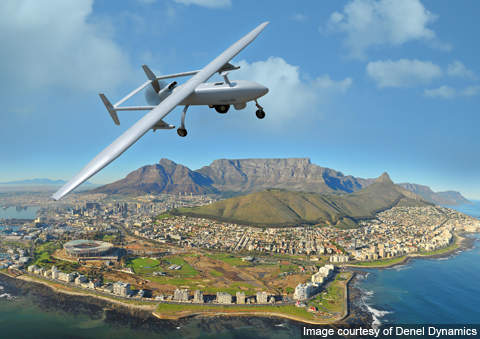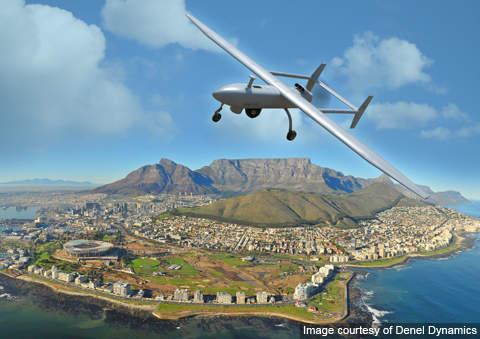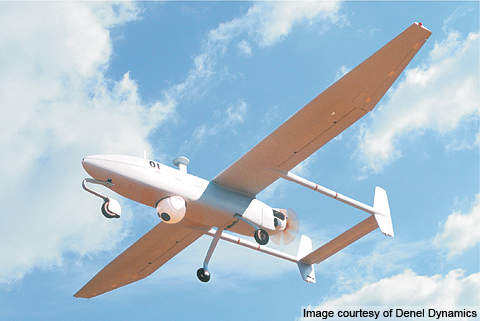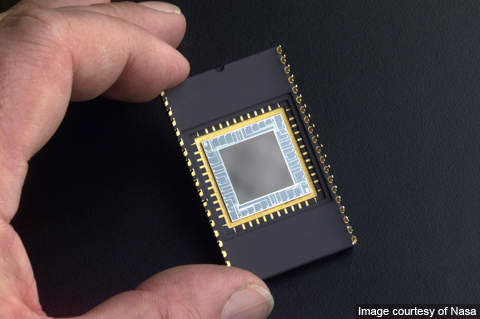Seeker 400 is an unmanned aerial vehicle surveillance system being designed and manufactured by Denel Dynamics, South Africa. Each system will comprise four to six unmanned aerial vehicles (UAV), a mission control unit (MCU), tracking and communication unit (TCU), aircraft payloads, thermal imaging camera, high resolution video camera and an optional tactical ground control station (TGCS).
The Seeker 400 is derived from its forerunner, the Seeker II aircraft. It is especially well suited to locate targets, endorse artillery fire and carry out electronic intelligence (ELINT) and electronic support measure (ESM) missions.
Flying at an altitude of up to 18,000ft, the Seeker 400 will render real time intelligence data by executing reconnaissance operations over a large area. It will capture the real time imagery of the battlefield and transmit to the TGCS through a satellite communication data link.
Seeker 400 UAV design
The Seeker 400 is designed to be 30% larger than Seeker II and will carry 100kg of payload. It can execute intelligence, surveillance, reconnaissance and target acquisition (ISTAR) operations both day and night even under worst climatic conditions. The vehicle can also perform border patrol, maritime patrol and target designation missions.
It is designed to carry two Impi laser guided missiles or two external fuel tanks on under wing hard points. The Impi is a missile being built by Denel Dynamics for a lightweight platform. The stand-off range of the missile will be 10km.
Development
The vehicle is currently in the final phase of development and its first round of flight tests were conducted in February 2014. The UAV with full payload onboard successfully met the range and performance requirements during the second round of flight tests conducted in July 2014.
Features
The Seeker 400 will feature all composite modular low drag airframe made up of carbon fibres to ensure maximum performance. The dual band data links will facilitate the vehicle to accommodate multiple payloads simultaneously. The aircraft will be equipped with a colour day light camera, infra-red thermal imager, black and white spotter camera, night spotter camera, Mode S transponder and very high frequency (VHF) AM air traffic control (ATC) radio for ATC interfacing.
An electro-optic camera will be incorporated beneath the front fuselage section to capture the imagery of battlefield. A directional antenna will be fitted on top of the front fuselage section to decrease jamming and facilitate communications up to 250km range from the control station. The operational range can be increased from 250km to 750km by passing the control to a forward deployed TGCS.
Sensors
The UAV can be equipped with any two payloads i.e. the Zeiss LEO III (electro-optic (EO), infra-red (IR)), electronic intelligence (ELINT) sensor, synthetic aperture radar (SAR) or an electronic surveillance payload (ESP) locating radar emitters.
Radars
The Seeker 400 will be incorporated with maritime radar, synthetic aperture radar (SAR), laser ranger finder, laser illuminator and communication intelligence (COMINT).
Engines
The Seeker 400 will be powered by a single four stroke aircraft engine, which produces 63.4kW of output power.
Ground control station
The MCU will act as an interface between the mission control crew and the vehicle. It will operate and monitor the aircraft as well as its payloads through commands.
The TCU is a separate unit that will keep track of the Seeker 400. It can be installed up to 200m away from the MCU to render maximum line of sight (LOS) communications.
The TGCS has the same functions as the MCU and TCU housed in one shelter. It is highly mobile and is deployed in the front line or on high ground to extend the UAV’s range. It is being developed by Denel Dynamics.
Performance
The Seeker 400 can fly at a maximum speed of 222km/h. The range and service ceiling of the aircraft will be 250km and 5,486m respectively. The UAV has an endurance of 16 hours.








